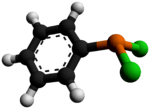Dichlorophenylphosphine
 | |
 | |
| Names | |
|---|---|
| Preferred IUPAC name
Phenylphosphonous dichloride | |
| Other names
Dichlorophenylphosphane Phenylphosphorus dichloride | |
| Identifiers | |
3D model (JSmol) |
|
| ChemSpider | |
| ECHA InfoCard | 100.010.388 |
PubChem CID |
|
| RTECS number | TB2478000 |
| |
| |
| Properties | |
| C6H5Cl2P | |
| Molar mass | 178.98 g·mol−1 |
| Appearance | colorless liquid |
| Odor | acrid, pungent |
| Density | 1.3190 g/mL |
| Melting point | −51 °C (−60 °F; 222 K) |
| Boiling point | 222 °C (432 °F; 495 K) |
| insoluble | |
| Solubility | miscible in benzene, CS2, chloroform |
Refractive index (nD) |
1.6030 |
| Hazards | |
| Safety data sheet | Fisher MSDS |
EU classification (DSD) (outdated) |
Corrosive (C) |
| NFPA 704 | |
| Flash point | 101 °C (214 °F; 374 K) |
| 159 °C (318 °F; 432 K) | |
| Lethal dose or concentration (LD, LC): | |
LD50 (median dose) |
200 mg/kg (oral, rat) |
Except where otherwise noted, data are given for materials in their standard state (at 25 °C [77 °F], 100 kPa). | |
| Infobox references | |
Dichlorophenylphosphine is an organophosphorus compound with the formula C6H5PCl2. This colourless viscous liquid is commonly used in the synthesis of phosphine ligands.
Dichlorophenylphosphine is commercially available. It may be prepared by an electrophilic substitution of benzene by phosphorus trichloride, catalyzed by aluminium chloride.[1] The compound is an intermediate for the synthesis of other chemicals for instance dimethylphenylphosphine:
- C6H5PCl2 + 2 CH3MgI → C6H5P(CH3)2 + 2 MgICl
In the McCormack reaction dichlorophenylphosphine adds dienes to give the chlorophospholenium ring.[2]
References
- ↑ B. Buchner and L. B. Lockhart, Jr. (1963). "Phenyldichlorophosphine". Organic Syntheses. ; Collective Volume, 4, p. 784
- ↑ W. B. McCormack (1963). "3-Methyl-1-Phenylphospholene oxide". Org. Synth. 43: 73. doi:10.15227/orgsyn.043.0073.
This article is issued from
Wikipedia.
The text is licensed under Creative Commons - Attribution - Sharealike.
Additional terms may apply for the media files.

